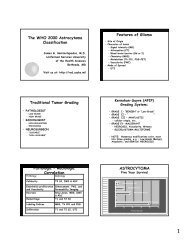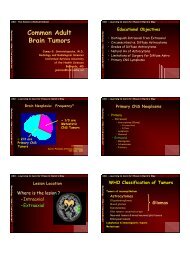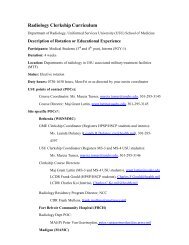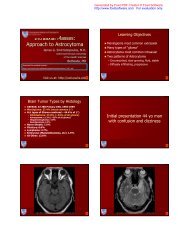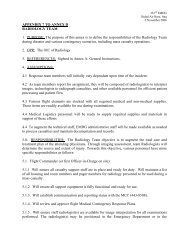MEMORANDUM FOR: RADIOLOGISTS DEPLOYING ... - Radiology
MEMORANDUM FOR: RADIOLOGISTS DEPLOYING ... - Radiology
MEMORANDUM FOR: RADIOLOGISTS DEPLOYING ... - Radiology
Create successful ePaper yourself
Turn your PDF publications into a flip-book with our unique Google optimized e-Paper software.
(b) In prone position insert styleted spinal needle 2-3 cm off midline at L2-3 level<br />
angled to course under the ipsilateral lamina under fluoroscopy.<br />
(c) In oblique bolstered position insert needle straight down in a bull’s eye fashion into<br />
the spinal canal through the boneless region under the lamina under fluoroscopy.<br />
(d) Remove stylet to confirm free flow of CSF out of hub after tactile sensation of<br />
passing the posterior longitudinal ligaments and thecal sac is felt.<br />
(3) Inject myelographic contrast under fluoroscopy to ensure free flow in thecal space.<br />
ii) Cervical Technique:<br />
(1) Stop medications that lower seizure threshold 24-48 hours prior<br />
(2) Place patient in prone position and ensure true lateral view on fluoroscopy.<br />
(3) Sterile prep of C1 – C4 on lateral neck<br />
(4) Place styleted spinal needle under fluoroscopy using bull’s eye technique anterior to the<br />
spinal lamina line at C1-2, staying in the posterior third of the spinal canal.<br />
(5) When needle on AP fluoroscopy is medial to lateral margin of dens, remove needle to<br />
check for free flow of CSF<br />
(6) Inject myelographic contrast under fluoroscopy to ensure free flow in thecal space.<br />
(a) DO NOT INJECT UNLESS FREE FLOW OF CSF IS SEEN<br />
(b) INJECTION IN TO THE CORD CAN CAUSE PERMANENT PARALYSIS<br />
iii) Myelographic Contrast<br />
(1) Dose: 3.06 g limit of intrathecal iondinated contrast medium in adults, 2.94g limit in<br />
children<br />
(2) Concentration: 300 mg / ml (10cc) limit in adults, 210 mg /ml limit in children.<br />
(a) Fluoroscopy should be used to determine correct amount of contrast administered<br />
(b) Patient with small thecal sacs require less than those with capacious ones<br />
(c) 200 cc / ml concentration for - pediatric patients, cervical , thoracic and lumbar<br />
myelograms<br />
(d) 300 cc / ml concentration for- total columnar myelography or cervical myelogram<br />
from lumbar injection.<br />
(3) Manufactures:<br />
(a) Use only contrast approved for intrathecal injection<br />
(b) Risk of arachnoiditis and nerve injury with non-approved contrast that is not free of<br />
preservatives or is not ultrafiltered<br />
(c) Bracco<br />
(i) Isovue-M 200 or Isoview-M 300<br />
(d) GE Healthcare<br />
(i) Omnipaque 180 or 240 or 300. (Do Not Use 140 or 350)<br />
iv) CT Protocol<br />
(1) Select slice thickness depending on region on interest and dose requirements depending<br />
on body habitus<br />
(a) Slice Thickness - 1mm , Increment - 1mm, Collimation -16 x 0.75, Pitch 0.69<br />
(b) Slice Thickness - 2mm, Increment - 1mm, Collimation -16 x 1.5, Pitch 0.95<br />
(2) Coronal and Sagittal Reconstructions<br />
v) Postprocedure Orders<br />
(1) Restrict activity for 24 hours with no heavy lifting or bending<br />
(2) Vigorous rehydration.<br />
(3) Elevation of head to limit contrast flowing intracranially. (increased risk of seizure)<br />
(4) Resumption of restricted medications after 24 hours.<br />
(5) Epidural blood patches for CSF leaks very effect at relieving spinal headaches.<br />
g) PACS Admin:<br />
i) Medweb Windows login: When you see DoD prompt, just hit return.<br />
(1) There is no logon or password. If you are asked one, hard reboot.<br />
(2) then, Medweb login: username: raddoc, Raddoc0!<br />
(3) For PC’s around the facility, providers can use the following indirect link to Medweb:<br />
(a) http://153.29.184.10/cobalt/<br />
(i) Login the same as above: username: raddoc, Raddoc0!<br />
J:\Projects\Combat <strong>Radiology</strong> Course\SOP August 2007.doc 5







